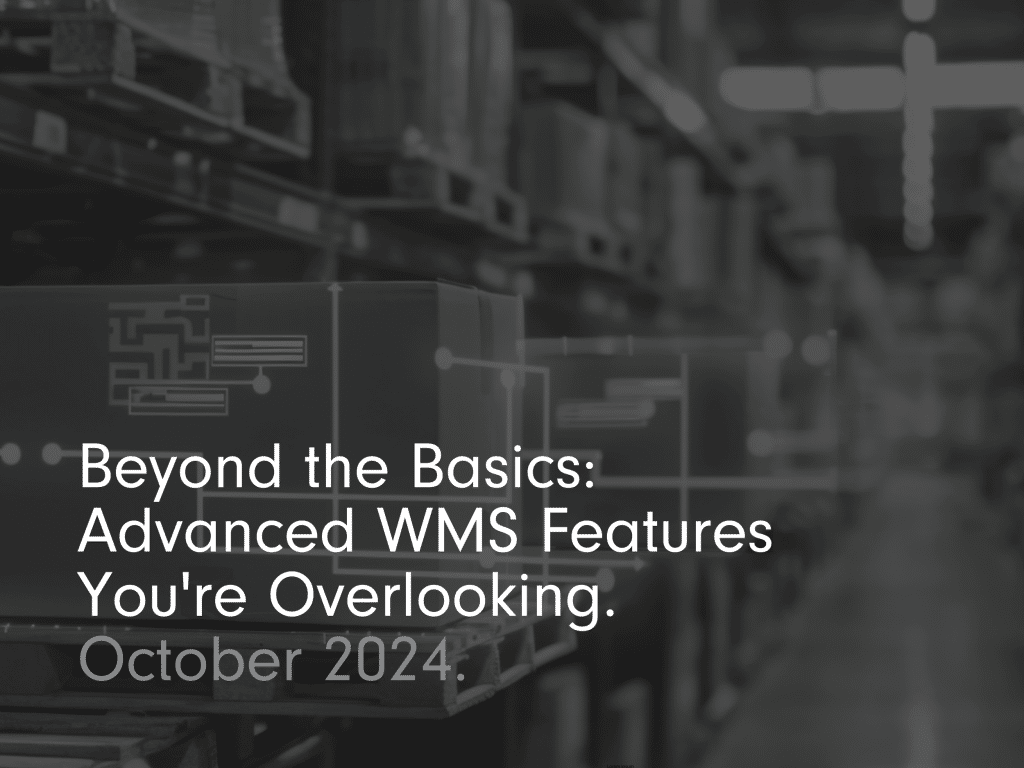Beyond the Basics: Advanced WMS Features You're Overlooking

In today’s fast-paced business world, efficiency and adaptability are crucial for staying ahead of the competition. A Warehouse Management System (WMS) is an essential tool. Many are familiar with its basic features like inventory tracking and order management, but there are advanced functions that often go unnoticed. These features can greatly improve your operations and give your business an edge.
This blog explores these advanced WMS features and how they can transform your warehouse operations, boost efficiency, and increase your profits. We’ll cover how each feature, from labour management to slotting optimisation, can significantly impact your supply chain.
The Art of Labour Management
One advanced feature that many overlook is labour management within a WMS. Efficient labour management ensures that the right tasks are assigned to the right workers, optimising productivity and reducing downtime. This feature helps track workers’ performance, allowing managers to allocate resources more effectively.
A WMS that includes labour management capabilities can provide insights into workforce productivity, helping managers identify areas where improvements can be made. It also facilitates the development of performance-based reward systems, which can motivate employees, leading to enhanced efficiency and morale.
By using labour management tools, warehouse managers can also plan more accurately, aligning workforce availability with demand fluctuations. This ensures that you always have the right number of staff on hand, avoiding the costs of overstaffing or the pitfalls of being understaffed.
Optimising Space with Slotting

Space is a premium commodity in any warehouse, and slotting optimisation is an advanced WMS feature that can significantly improve how space is utilised. Slotting optimisation involves determining the most efficient placement for each product within the warehouse, minimising travel time and maximising picking efficiency.
The use of slotting optimisation helps reduce the time it takes for pickers to locate items, thus speeding up the order fulfilment process. By placing high-demand items in easily accessible locations, this feature ensures quick retrieval, enhancing productivity.
Additionally, slotting optimisation can adapt to changes in product demand and inventory levels, continually reassessing and adjusting item placements to maintain optimal efficiency. This dynamic adjustment allows warehouses to be more responsive to market demands, ensuring they can meet customer expectations without delay.
Multi-Channel Fulfilment Made Easy

In today’s omnichannel retail environment, multi-channel fulfilment is more important than ever. A WMS with multi-channel fulfilment capabilities can seamlessly manage orders from various sales channels, whether online, in-store, or through third-party partners.
This functionality ensures accurate inventory counts across all channels, preventing overselling and stockouts. It also provides a unified view of inventory, making it easier to allocate stock to the right channels based on demand and profitability.
Furthermore, multi-channel fulfilment allows for flexible delivery options, such as buy-online-pickup-in-store (BOPIS) or ship-from-store, enhancing customer satisfaction and loyalty. By streamlining processes across multiple channels, businesses can offer a seamless shopping experience, which is crucial in today’s competitive market.
Enhancing Efficiency with Smart Cart Technology

Smart Cart technology is at the forefront of revolutionising warehouse operations. This WMS feature automates the picking and packing process, making it more efficient and reducing errors. With Smart Carts, pickers are guided through the warehouse, minimizing travel time and maximising pick density.
The technology uses volumetric data to assign orders to Smart Carts, ensuring optimal space utilisation. This reduces unnecessary trips and enhances picking routes, allowing workers to complete more orders in less time.
By implementing Smart Cart technology, warehouses can significantly increase their throughput, reducing labour costs and improving order accuracy. This leads to faster fulfilment times and higher customer satisfaction.
Mastering Inventory with Directed Putaway

Directed Putaway is an advanced WMS feature that automates the process of placing received goods into storage locations. Instead of relying on staff knowledge, the system uses configurable logic to determine the best location for each item based on factors such as size, weight, and demand.
This feature improves space utilisation by ensuring that goods are stored efficiently, reducing travel time and minimising errors associated with manual put away. It also enhances stock accuracy by maintaining a real-time view of inventory, preventing misplaced or lost items.
Directed Putaway reduces the reliance on experienced staff, as the system guides operatives to the correct storage locations, facilitating training and integration of new employees. This automation leads to smoother operations and quicker adaptation to changes in inventory levels or product lines.
Streamlining Processes with Advanced Replenishment

Advanced replenishment within a WMS automates the process of restocking pick faces, ensuring that the correct levels of inventory are maintained at all times. This feature uses system-driven logic to initiate replenishment tasks when stock levels fall below predefined thresholds.
By efficiently grouping replenishments, the system minimises unnecessary travel and ensures that replenishment runs are completed in a timely manner. This prevents stockouts and reduces downtime, keeping operations running smoothly.
Implementing advanced replenishment not only boosts productivity, but also improves inventory accuracy, as the system maintains consistent stock levels without manual intervention. This leads to improved customer satisfaction, as orders are fulfilled promptly and accurately.
Ensuring Quality with Automated Inspection
Quality control is paramount in any warehouse operation, and automated inspection within a WMS ensures that quality checks are conducted systematically. This feature provides operatives with a customised set of questions during inspections, guiding them through the process and documenting results.
Automated inspection allows for multiple levels of quality control, with actions influenced by the weight of inspection responses. Items can be held until they pass quality checks, ensuring that only compliant products reach customers.
By systemising quality inspections, warehouses can reduce errors associated with manual checks and ensure consistency across all processes. This leads to higher product quality and customer trust, enhancing the overall brand reputation.
Efficient Assembly with WMS Support
For operations requiring kitting or light assembly, a WMS with assembly functionality automates these processes, providing visibility throughout. The system sends out work orders when assembly is needed, guiding users to gather components and assemble them into new SKUs.
This feature tracks the status of assembled products, ensuring accurate labelling and order fulfilment. By automating assembly tasks, warehouses can reduce labour costs and minimise errors, improving efficiency and product quality.
With assembly functionality, businesses can expand their product offerings and respond to market demands more flexibly. This adaptability is key to staying competitive and meeting diverse customer needs.
Prioritising Orders with Precision
Order prioritisation within a WMS allows businesses to manage and dispatch orders based on importance. By using attributes such as customer, product, location, or carrier, the system determines which orders should be prioritised for fulfilment.
This feature removes manual intervention, as the system automatically structures orders to maximise productivity and efficiency. By ensuring high-priority orders are processed first, businesses can enhance customer satisfaction and loyalty.
Order prioritisation also enables better resource allocation, ensuring that labour and equipment are used effectively. This leads to cost savings and improved operational efficiency, setting businesses apart from competition.
Elevating E-Fulfillment for E-Commerce
In the realm of e-commerce, efficient e-fulfillment is crucial for managing high volumes of single-line orders. A WMS with e-fulfillment capabilities streamlines picking and packing processes, reducing the time and effort required for order completion.
By aggregating items for bulk picking, the system minimizes trips and enhances productivity. This allows businesses to handle large order volumes with ease, meeting customer expectations for prompt delivery.
E-fulfillment also provides greater visibility into order status and inventory levels, ensuring accuracy and preventing stockouts. This leads to more reliable service and happier customers, driving growth and success in the e-commerce space.
Simplifying Documentation with Image Management
The Image Management module within a WMS offers a digital solution for document storage and retrieval. By using OCR technology, the system converts paper-based documents into secure digital files, ensuring accessibility and immutability.
This feature reduces the risk of document loss or damage, as files are stored electronically and can be easily retrieved based on metadata. Image management also facilitates process documentation, providing evidence in cases of disputes or quality control issues.
By transitioning to digital documentation, businesses can enhance efficiency and reduce costs associated with paper-based systems. This leads to more streamlined operations and improved compliance with regulatory requirements.
Coordinating Operations with Scheduling
Scheduling functionality within a WMS allows businesses to book appointments for inbound and outbound deliveries, ensuring efficient management of dock activities. By using a calendar view, the system provides visibility into scheduled appointments, facilitating coordination with carriers and suppliers.
This feature ensures that deliveries are organized and timely, reducing the risk of bottlenecks or delays. By attaching relevant documents to scheduled appointments, businesses can streamline processes and improve communication.
Scheduling also enhances resource allocation, ensuring that staff and equipment are used effectively. This leads to cost savings and improved operational efficiency, enhancing overall business performance.
Conclusion
Advanced WMS features offer significant opportunities for businesses to enhance their operations and set themselves apart from the competition. By leveraging functionalities such as labour management, slotting optimisation, and multi-channel fulfilment, warehouse managers can improve efficiency, reduce costs, and enhance customer satisfaction.
These hidden gems within a WMS provide valuable insights and tools for optimising warehouse processes, enabling businesses to stay agile and responsive in today’s dynamic market. By exploring and implementing these advanced features, supply chain directors and operations managers can drive growth and success for their organisations.
If you’re ready to take your warehouse operations to the next level, it may be time to explore these advanced WMS functionalities. For further insights and guidance, consider reaching out to industry experts or WMS providers who offer tailored solutions to meet your unique needs.
Frequently Asked Questions.
Advanced WMS features include labour management, slotting optimisation, e-fulfilment capabilities, assembly functionality, scheduling, and image management. These features help improve efficiency, reduce costs, and enhance customer service by providing valuable insights and tools for warehouse process optimisation.
Yes, a WMS can be integrated with other systems such as Enterprise Resource Planning (ERP), Customer Relationship Management (CRM), and Transportation Management Systems (TMS). This integration allows for seamless data exchange and improved coordination across various business functions.
Effective putaway improves warehouse operations by reducing labour costs, speeding up order fulfilment, minimising errors, and enhancing overall workflow efficiency. It also contributes to better space management and helps maintain inventory accuracy.
For more information on optimising your warehouse’s putaway process, consider consulting with industry experts or leveraging advanced WMS solutions tailored to your specific needs.